
Portland Magazine
February 17, 2021
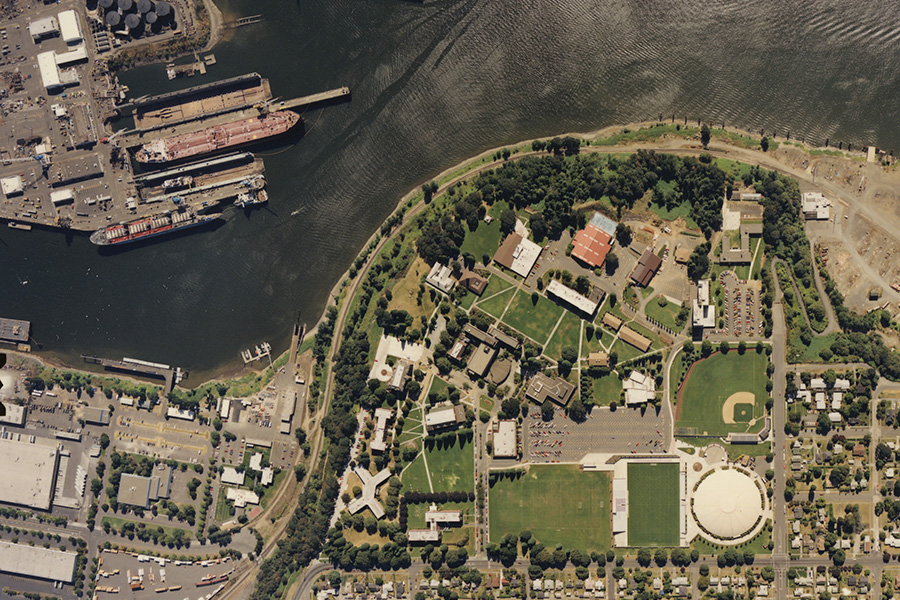
By purchasing land along Portland Harbor—known for its legacy of industrial pollution—University of Portland committed to a new level of environmental stewardship. The neighborhood is taking notice.
By Rachel Ramirez
Before the University of Portland bought the 35-acre patch of land below Waud’s Bluff and called it Franz River Campus, the area had already acquired many names. It had been known as Pirate Town, Creosote Factory, SuperFun Site, and officially Triangle Park.
This parcel of land also came with a reputation, more recently for graffiti, abandoned factories, and illegal activities. But its long-standing reputation is still for the historically massive industrial and environmental pollution it contributed along Portland Harbor.
Since the 1900s, the North Portland property—along with the neighboring McCormick & Baxter site, still owned by the creosote company—has been redeveloped and tainted by nearly 50 industrial operations, including a lumber mill, concrete packing plant, metal working plant, dry docks, waste storage tanks, and a power plant.
In 2000, eight years prior to UP’s purchase, Portland Harbor was declared a Superfund site, a polluted area contaminated with hazardous substances that required a long-term cleanup. McCormick & Baxter was also declared a Superfund site. Triangle Park (now Franz River Campus) received a different designation: it was declared an orphaned brownfield site—a contaminated land abandoned by a property owner who didn’t have the means to pay for a cleanup.
Buying the land meant that the University was also buying into an enormous responsibility. If UP purchased the land, the University would need to take part in cleaning it up—both the property’s contaminated soil and groundwater as well as the riverbank—according to requirements stipulated by the City of Portland, the Oregon Department of Environmental Quality (DEQ), the federal Environmental Protection Agency (EPA), the Oregon Department of State Lands, and tribal representatives.
Given the immense scale of the cleanup, was the University up to the task?
More than 10 years into the process, it turns out UP was up for the undertaking and may even be creating a blueprint for how other universities can work hand-in-hand with public entities to clean up contaminated land and make it usable for future generations.
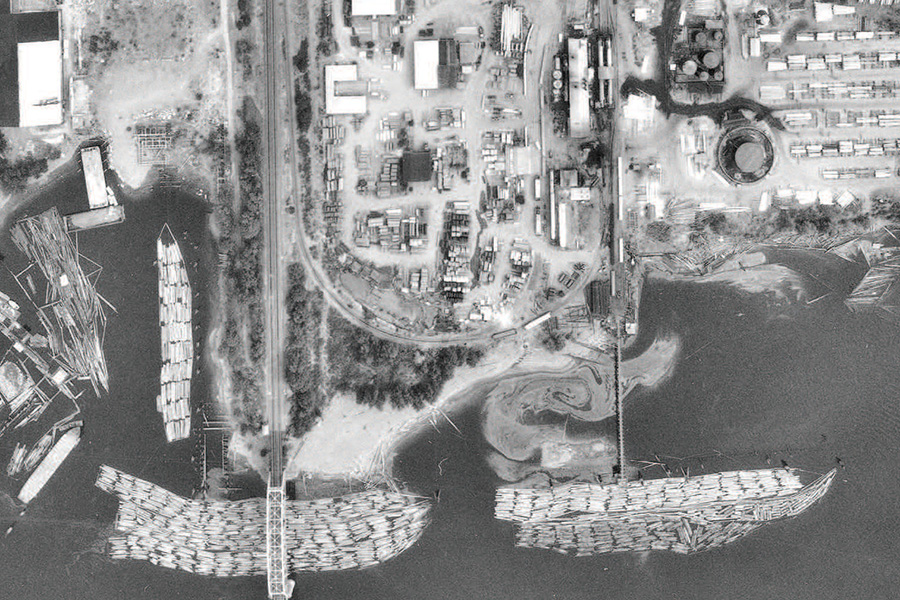
Aerial view of the McCormick & Baxter site operations, 1973. Photo courtesy of Oregon Department of Environmental Quality.
For centuries, the Willamette River was home to many of Oregon’s tribal nations such as the native Multnomah, Wasco, Cowlitz, Kathlamet, Clackamas, Bands of Chinook, Tualatin, Kalapuya, and Molalla. The water, once clean and pure, served as their livelihood, fishing for salmon and smelt. In the early 1800s, British and American settlers arrived and traded with the thriving villages scattered along the Willamette and Columbia Rivers. But their arrival also brought deadly epidemics like smallpox and measles that essentially wiped out Portland Harbor’s Indigenous people. The erasure of the native villages, coupled with a flood of white settlers, altered the ecological and environmental landscape along the river forever.
Industrialization brought pollution. Shipping vessels traveled up and down Portland Harbor and would often dock in Triangle Park’s low-lying ports. While these industrial ports were major hubs for economic activity (particularly post- World War II), they were also major sources of contamination.
Ships that run on dangerous amounts of fossil fuel, the diesel-powered machinery and freight trucks transporting cargo, combined with dust and noise pollution, all elevate levels of green- house gas emissions released into the air, land, and water. The shipping industry’s workers, many of whom were Black folks who migrated north from the Deep South looking for jobs, were exposed to these toxic chemicals.
In the 1970s, the 35-acre site was owned by Riedel International, an industrial company that dredged rivers, constructed boats, and soon became involved in hazardous waste spill cleanups near the railroads. In 1984, Riedel International got a permit to build a hazardous waste storage building in the area, which sparked widespread opposition and protests from the North Portland neighborhood. Although Riedel shuttered its operations in 1986, the environmental harms still linger in the site’s soil and groundwater.
According to an environmental assessment by the Oregon Department of Environmental Quality (DEQ), the soil—which has since been excavated and disposed of off-site—was contaminated with toxic chemicals such as polychlorinated biphenyls (PCBs), arsenic, lead, copper, asbestos, chromium, and nickel. The groundwater, meanwhile, was tainted with diesel fuel oil, gas, lead, and more. Scientists say long-term exposure to these chemicals could lead to severe health conditions such as asthma, cancer, and other respiratory health illnesses.
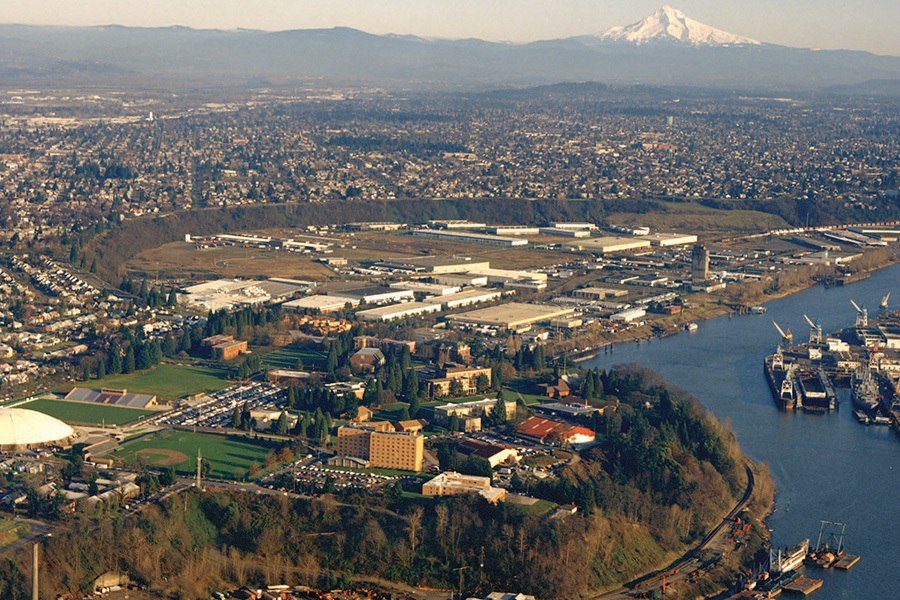
View from the west of Triangle Park and University of Portland, 1991. Photo courtesy of Ackroyd Photography, Inc.
After President Richard Nixon’s creation of the landmark Environmental Protection Agency in 1970, a slew of environmental protection policies and regulations followed. According to the 1972 Clean Water Act, it is against the law to discharge any pollutant from any point source such as pipes or man-made ditches into navigable waters, like the Willamette River, unless a permit was obtained. The National Pollutant Discharge Elimination System (NPDES) was also formed to mitigate water pollution and set up pollution monitoring. The NPDES minimized pollution by industrial companies, factories, and even individuals, but it didn’t end the contamination altogether.
Since the early 2000s, a growing number of environmental cleanups have emerged. Today, cleanup of the Portland Harbor Superfund site—which stretches for 11 miles from the Broadway Bridge to Sauvie Island—is still ongoing. University of Portland became one of the cleanup pioneers after purchasing property along the polluted harbor.
Local grassroots organizations are playing a role too.
“[Because of] this legacy contamination, we know we can’t make the site and the river truly pristine again,” says Cassie Cohen, the executive director of Portland Harbor Community Coalition, an environmental justice group. “But the cleanups are so important for the health of future generations to be able to have access to healthy soil and water and air.”
Cohen’s organization aims to uplift the voices of those most impacted by pollution in the Portland Harbor Superfund site. “Grassroots efforts [at the height of the growing industrial business along the river] were...lacking for impacted communities like tribal groups, the Black community, immigrants and refugees, and houseless communities, to weigh in.... Most folks have no idea really the extent of the toxicity that still remains today.”
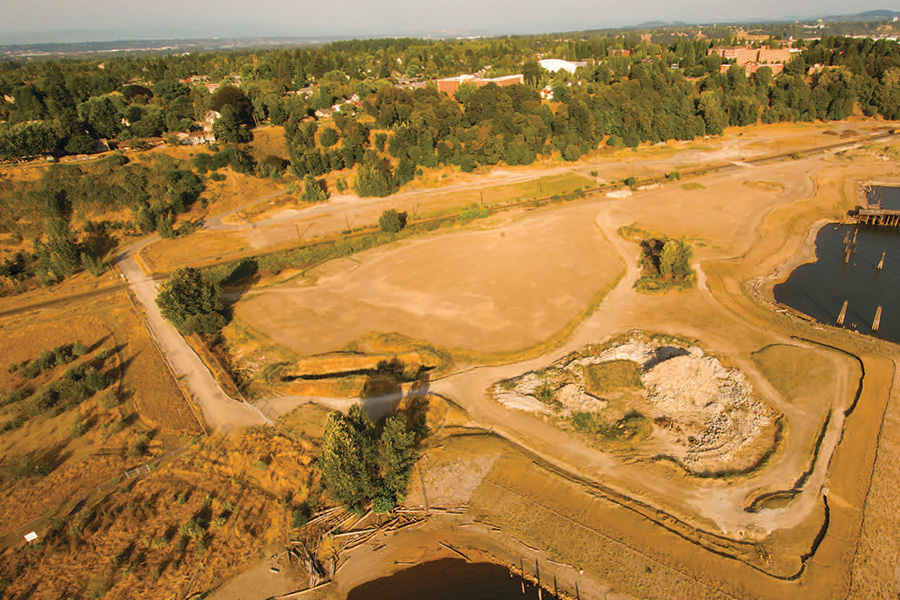
A heat wave during the summer of 2013 meant a lot of the vegetation had to be replanted. Photo by Bruce Forster.
The University, led by the efforts of longtime UP leader and community liaison Jim Kuffner, took its first swing at buying part of the industrial land in 1997. (Funds for this bid and the later purchase came from private sources earmarked specifically for land development.) Although the attempt was unsuccessful due to the low price it offered, the University still managed to buy a small 7-acre parcel of the land behind Corrado Hall. Meanwhile, the rest of the property was purchased by industrial barge builder Jay Zidell through a company called Triangle Park, LLC. Zidell made an agreement with the DEQ to indemnify him from existing liabilities on the site, but failed to make an agreement at the federal level—which became a major obstacle once the EPA declared the Portland Harbor a Superfund site, and was searching for property owners that may have contributed to the harbor’s contamination.
Since Zidell was already facing challenges in terms of cleaning up the land, the University—still interested in the property—negotiated with Zidell, the DEQ, and the EPA to do whatever was necessary to clean up and revitalize the former industrial site through a process overseen by the EPA. Purchase negotiations between Zidell and the University dragged on for years and hit more than a few stumbling blocks.
In December 2008, the University successfully bought the 35-acre site for $6 million—$1.2 million of which (the same amount that the EPA fined Zidell) was added to the University’s standing $3 million contribution fund to clean up the site.
Even after the deal closed, Kuffner says the cleanup of what is now Franz River Campus did not begin in full swing until the summer of 2012. As part of the purchase agreement with the Oregon DEQ and the EPA, the University spent the following years assessing the land with the help of environmental consulting agencies, taking hundreds of soil and groundwater samples, removing and excavating contaminated soil both on site and along the riverbank—which they later had to cover and revegetate, investing nearly a million dollars in environmental consulting studies and coming up with a redevelopment design plan of the land.
“It took that long. All of 2009, 2010, 2011 and half of 2012, as well, before we were able to reach a complete understanding and agreement on what the scope and the nature of the cleanup would be,” Kuffner says. “What got the University, too, was the level of cleanup. We did not have the resources to clean up the property to the level that would have provided for housing, so we ultimately ended up with a level of what’s called recreational and operational uses.”
The University met the EPA standards and completed the cleanup in 2014. As it stands, residence halls or dormitories cannot be built on River Campus due to restrictive zoning that limits the land use to only an occupational and recreational level. Perhaps in the far-off future, Kuffner says, that might change. But for now, the University plans to stick with recreational and occupational uses and continue working with the DEQ as it brings its vision to life: more athletic facilities, a new physical plant, a boathouse, and an environmental education center (plans for which have been pushed further into the future because of the impact of the global pandemic on the University’s finances).
“After completing cleanup work for EPA, the University began working with DEQ to ensure the development of the Franz River Campus maintains the environmental protections put into place during the cleanup,” says Lauren Wirtis, a spokesperson for the DEQ. “The University has been and continues to be proactive in informing and involving DEQ in site development activities, and works cooperatively with DEQ to conduct site work in an environmentally sound manner.”
UP also needed a comprehensive plan to rehabilitate the riverbank’s ecological damages. The University partnered with the Oregon Department of State Lands (DSL) to evaluate and design a shoreline restoration project in both UP-owned and DSL-owned properties. The project had to go through the Portland Harbor Natural Resources Trustee Council, which consisted of three government representatives and five tribal represent- atives, including the Confederated Tribes of Siletz Indians and Umatilla Indian Reservation.
UP is now working on its shoreline properties separately from the DSL and has pledged to continue its stewardship in managing and restoring the riverbank in concert with the development of the Franz River Campus.
Kuffner says he is proud of the work the University has done in cleaning up the land. In December 2019, he retired from the University after 35 long years, but he still lives a walking distance away from campus and continues to volunteer his time in the community.
“In my 35 years working there, I’ve walked the campus many, many times and just felt how blessed I am to be at a place like this that has a good mission working with young people, trying to develop the best that they can for the world and the future,”Kuffner says. “‘What a great day to be on campus,’ I always liked to say.”
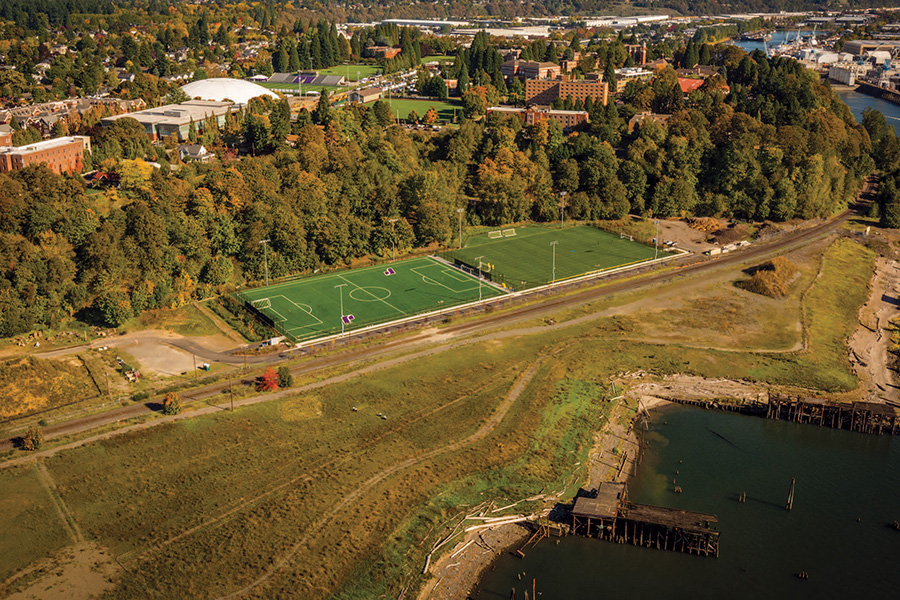
UP’s Franz River Campus practice fields, 2019. Photo by Bruce Forster.
Michael Pouncil, 50, moved to Portland the same year the University bought Triangle Park. When Pouncil bought his North Portland house, just a few blocks away from campus, his real estate agent didn’t tell him he would be living in close proximity to Superfund sites. It wasn’t until he became involved in the movement to restore and protect urban rivers that he found out about the vast swath of contaminated properties along the Willamette River.
“If I had known that I’d be purchasing a home near a Superfund, I probably would have looked somewhere else,” he says. “But then I wouldn’t have learned about the history of the place and [gotten] to know my community. Despite these horrible disparities in the community when it comes to environmental injustice and pollution here, I still love my community. It has its own rough-edge beauty to it. It’s actually been a bizarre blessing in a way.”
Pouncil applauds the University for understanding the industrial history and trying to repair the damages done by legacy pollution in Triangle Park, but he still finds it shocking whenever he encounters residents of North Portland who have no idea about the history of pollution along Portland Harbor. As the chair of the Portland Harbor Community Advisory Group, he’s been trying to spread awareness of the river and shoreline cleanups by putting up flyers at grocery stores, hosting events, facilitating forums or meetings, and even going door to door in the neighborhood.
“Five years of doing this work, and it still surprises me that people are surprised to hear about the river’s history,” Pouncil says. “It shows you how strong the message is that Portland dubs itself as a green and renewable city, when we actually have one of the top largest Superfund sites in the country.”
In the middle of a pandemic, Pouncil and Cohen have been fighting a different cleanup battle at another contaminated site next to McCormick & Baxter. The site, called Willamette Cove, is being cleaned up by Portland’s Metro Council. However, community members say that the council is only committed to doing the bare minimum with no equitable development plan. Jim Ravelli, University of Portland’s vice president of operations, who’s also been a key part of the Triangle Park venture, recently sent a letter to Metro Council urging them to take caution and listen to community members’ concerns.
As for Triangle Park, people have been receptive to the changes. “Folks have really liked the transition from what it was to what it is now,” Ravelli says. “It was a very congested, very industrial place. But to turn it into a park-like setting and restore it to something that is not only going to be enjoyed by our students, but also the community—they’re really liking the transition. And I think it just speaks to UP’s stewardship.”
Trang Lam, who took over Kuffner’s reins to oversee the redevelopment of the 35-acre property, is also part of the North Portland community. Just like Kuffner, Lam has been key in putting together the last pieces of the development puzzle, such as getting permits and passing additional Greenway reviews, which are the city’s requirements to allow public access, flood protection, and other potential impacts to the environment. Before her recent departure to a director position with Parks and Recreation in Camas, WA, she had been engaging with community organizations like the Portland Harbor Community Coalition.
“We have very transparent conversations with the community, and especially with a large construction like this, we want to make sure that we’re being safe,” Lam says. “The University, in the context of redeveloping the Triangle property into Franz River Campus, is really a trailblazer for not just North Portland, but for the city, in general, as far as cleaning up the shoreline.”
Walking around Franz River Campus today, one never would have thought that a large smokestack and industrial plant used to occupy the space. The University has successfully installed parking lots and soccer fields for athletes to practice. Ravelli said a new physical plant facility is still one of their top priorities, as are the proposed dock and boathouse, a track, and an environmental studies learning center, which Lam said she’s most ecstatic about since it marries the community benefits of recreation with environmental and ecological scholarship. A new tennis center is another facility they’re looking into installing in the future. In response, community advocates say the University has been doing a laudable job so far.
“I believe it’s going to be an amazing feather in the cap for the University to have a campus that’s waterfront property right next to it,” says Pouncil.“I’d say kudos to UP, and if anything, they are a catalyst to getting these heavy industrialized and polluted sites cleaned up. It’s good to see someone in the private sphere take an ecological approach to cleaning up the mess that historical polluters have left behind.”
While Franz River Campus is just a small patch of land compared to the rest of the contaminated properties along Portland Harbor, Kuffner hopes that University of Portland could be a model for other properties along the river. Portland, like many other major cities across the country, still faces legacies of injustice in its communities. For now, environmental justice advocates like Pouncil and Cohen vow to continue the fight for clean air, land, and water so that Portland can fully live up to its image of a green city.
“For 100 years or more, the University of Portland has identified itself as this beautiful campus, on The Bluff, overlooking the Willamette River. With the acquisition of the property down there, we now get our feet wet,” Kuffner says. “In that context, we embraced what we could do to restore and return that property to the best kind of beneficial reuse, which serves not only the University and generations to come, but [also] serves the memory of the people who were there before.”
RACHEL RAMIREZ ’18 is an environmental justice reporter based in New York City. You can find her work at various publications including Vox, HuffPost, The Guardian, Rolling Stone, Grist, and more.
University of Portland
5000 N. Willamette Blvd.,
Portland, Oregon 97203-5798
503.943.8000
This website uses cookies to track information for analytics purposes. You can view the full University of Portland privacy policy for more information.
